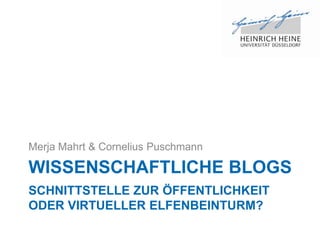
Wissenschaftliche Blogs: Schnittstelle zur Öffentlichkeit oder virtueller Elfenbeinturm
- 1. Merja Mahrt & Cornelius Puschmann WISSENSCHAFTLICHE BLOGS SCHNITTSTELLE ZUR ÖFFENTLICHKEIT ODER VIRTUELLER ELFENBEINTURM?
- 2. 2
- 3. 3
- 4. Forschung zu wissenschaftlichen Blogs Fokus auf Bloggern Wer bloggt? Warum? Arten von Blogs PhD-Blog, Rezensionen von Studien, Darstellung eigener Forschung „virtuelle Kaffeepause“ 4
- 5. 5
- 6. 6
- 7. Rezeption wissenschaftlicher Blogs Blognutzung Wissenschaftliche Blogger lesen andere wissenschaftliche Blogs D: 7%, USA: 33% der Bevölkerung nutzen Blogs allgemein Wer liest welche Arten von wissenschaftlichen Blogs? Zu welchem Zweck? Welche Arten von Öffentlichkeiten bilden sich? 7
- 8. Fallstudien zu wissenschaftlichen Blogs Definition über Inhalte Anlassorientierung Blogs zu Peer Review-Veröffentlichung: Arsen-Bakterien Risiko- und Krisenkommunikation: EHEC Inhaltsanalyse von 491 Blogkommentaren zu zehn ausgewählten Blogbeiträgen 8
- 9. Verständlichkeit 100% 90% Sprache der 80% Kommentare 70% Alltagssprache 60% 50% einf acher/mittlerer wiss. Anspruch 40% hoher wiss. 30% Anspruch 20% 10% 0% Alltagssprache einf acher/mittlerer hoher wiss. wiss. Anspruch Anspruch Sprache der Blogs n = 108, 3 Blogs n = 306, 5 Blogs n = 70, 2 Blogs 9
- 10. Status der Kommentierenden 100% 90% 80% 70% nicht zu erkennen 60% Laie 50% Experte 40% 30% 20% 10% 0% Arsen EHEC n = 275, 6 Blogs n = 156, 4 Blogs 10
- 11. Anlässe für Kommentare 80% 70% Zusatz, Ergänzung 60% Zustimmung 50% Kritik, Widerspruch 40% Danksagung, Anerkennung 30% Frage 20% Handlungsempf ehlung, Rat 10% 0% Arsen EHEC n = 262, 6 Blogs n = 200, 4 Blogs 11 Bis zu zwei Anlässe codiert
- 12. Gratifikationen 100% 90% 80% 70% 60% Arsen 50% n = 273 40% EHEC 30% n = 156 20% 10% 0% 12
- 13. Schnittstelle zur Öffentlichkeit oder virtueller Elfenbeinturm? Potenzial für direkten Austausch zwischen Wissenschaft(lern) und Öffentlichkeit Fachdiskurse Vermittlung und Austausch mit Laien Unabhängig vom Thema entscheidet die Form des Blogbeitrags 13
- 14. Fazit Wissenschaftliche Blogs in Thema und Stil vielfältig Form und Inhalt des Blogs beeinflussen Leser und Kommentare Informations- und Diskussionsbedarf Geplant: Befragung von Bloglesern zu ihren Interessen, Nutzungsgewohnheiten und Motiven 14
- 15. Vielen Dank Dr. Merja Mahrt & Dr. Cornelius Puschmann nfgwin.uni-duesseldorf.de >> Conference on Science and the Internet << 1.-3. August 2012 mahrt@phil.uni-duesseldorf.de 15
- 16. Quellen Busemann, K., & Gscheidle, C. (2011). Web 2.0: Aktive Mitwirkung verbleibt auf niedrigem Niveau. Media Perspektiven, (7-8), 360-369. Kjellberg, S. (2010). I am a blogging researcher: Motivations for blogging in a scholarly context. First Monday, 15(8). Kouper, I. (2010). Science blogs and public engagement with science: Practices, challenges, and opportunities. Journal of Science Communication, 9(1), 1-10. Pew Research Center (2010). Generations 2010. Pew Internet and American Life Project. Abgerufen am 25. October 2011 von http://pewinternet.org/~/media//Files/Reports/2010/PIP_Generations_and_T ech10.pdf 16
